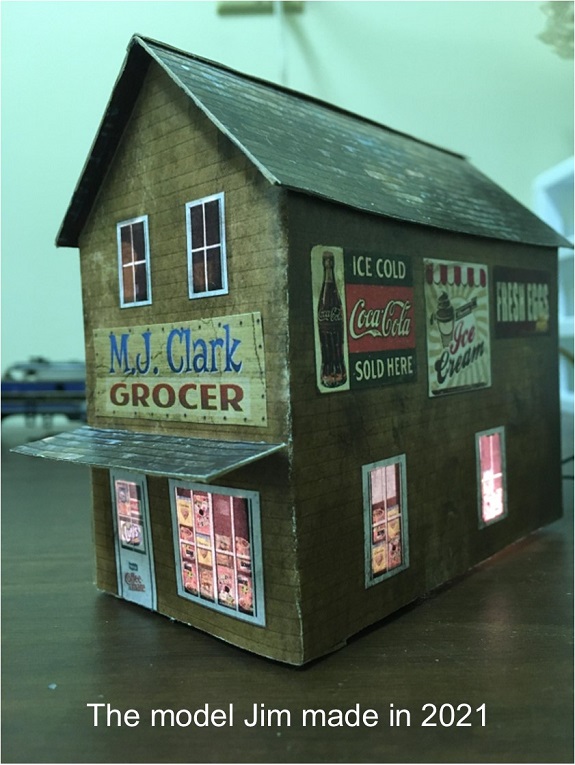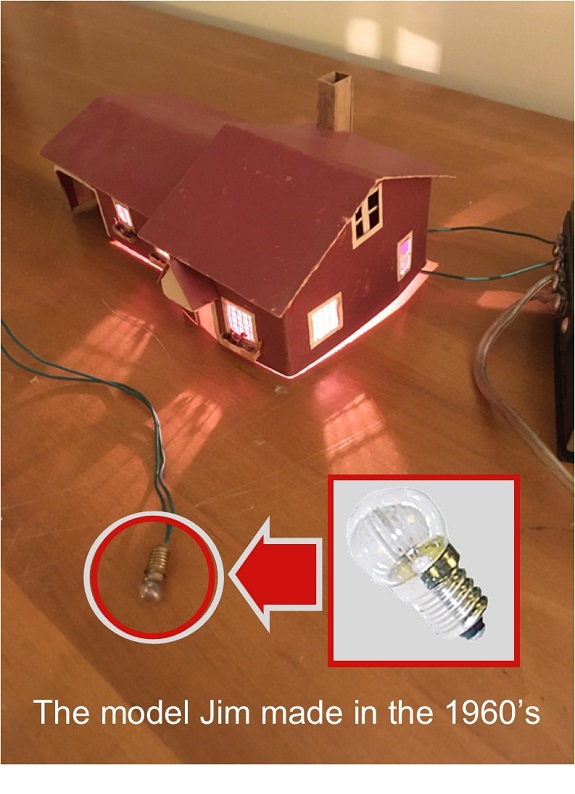Everything on model trains, model railroads, model railways, locomotives, model train layouts, scenery, wiring, DCC and more. Enjoy the world's best hobby... model railroading!
Lighting Paper Model Buildings
Jim Brown kindly sent in this informative article and photos to share and would like some feedback from others.

Jim made this general store building from a plan he downloaded at https://www.modelbuildings.org
“I downloaded your the small general store plan from your website and was very impressed with the results. I wanted to share a modification I made to the model that turned out better than I expected.
I like to have my models lit, so before I glued down the paper I decided to mark the inside corners of the windows on the cardboard with a straight pin, remove the paper and cut out the opening, and then glue on the paper.
To elaborate, what I did was cut out the cardboard and the picture separately. Then I put the picture over the cardboard and marked each inside corner of the windows with a straight pin. I wanted the holes to be as inconspicuous as possible on the paper copy. It is important that you mark the inside corners of the windows to get the right effect. Next, I removed the paper and connected the window dots that were made by the straight pin and cut out the openings in the cardboard. After all the openings were cut out I glued the paper onto the cardboard cutout, assembled the store, and voila, when I lit the store here is the effect I got. The only difficulty I had was keeping the cutouts registered with the paper’s windows when I folded the store into shape.
When lit up the results were very good. What impressed me was the illusion that the window looked like it was inside the store when lit. This was a fun project. I would really love some feedback on what you think of my modification.

Jim made this building as a youth in the ’60s. He cut out the windows and used low voltage incandescent lights hooked up to his transformer accessories.
As a youth, back in the mid-60s, I had a small HO train layout. I made this for my grandchildren who are now getting into HO trains. They loved it. I will be using this technique on future projects.
On the topic of electrical safety and heat output from lighting buildings, especially paper ones, I don’t have the expertise to advise anyone.
I don’t personally believe low voltage LED’s can produce enough heat to create a fire hazard, even in an enclosed space like the paper store model I made. I have not found any low voltage LEDs that have gotten more than warm to the touch.
The buildings I made in the ’60s as a youth had all the windows cut out and I used low voltage incandescent lights hooked up to my transformer’s accessories, so there was plenty of ventilation. For the picture I sent you, I set the store over one of the lamps I used back then.
My plan for the grandchildren is to use low voltage, warm white LED’s mounted on a stand or onto their layout board itself and set the buildings over the lamps. I feel comfortable with this decision, but I don’t feel comfortable advising others on the subject. It is something to think about when using this technique with your models.
The photo above is the house we lived in that I made as a youth for my train layout with the lamps I used. I have 5 other homes I made that were all lit up the same way. Considering how young I was at the time and the resources available to me back then it made for a nice looking layout.”
Jim has indicated he would like to hear ideas from others in the hobby, including comments on using LED lights, heat output, etc. If you have an article and photo you would like to share with others, please contact the Blog Moderator with details by using the ASK A QUESTION link below.
A free catalog of 200+ model building plans is available from https://www.modelbuildings.org














